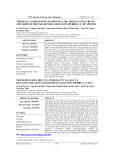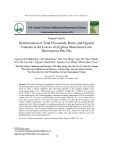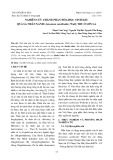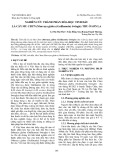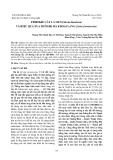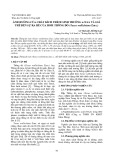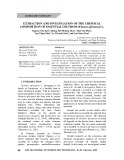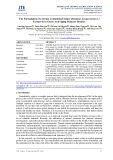
HPU2. Nat. Sci. Tech. Vol 03, issue 03 (2024), 43-51.
HPU2 Journal of Sciences:
Natural Sciences and Technology
Journal homepage: https://sj.hpu2.edu.vn
Article type: Research article
Received date: 08-8-2024 ; Revised date: 04-10-2024 ; Accepted date: 04-11-2024
This is licensed under the CC BY-NC 4.0
43
An investigation into the morphological and anatomical
characteristics of three cassava (Manihot esculenta) varieties
collected from the Northern provinces of Vietnam
Van-Tien Tran
a
, Kim-Tien Nguyen Thi
b
, Lan-Huong Do Thi
b
*
a
National Academy of Public Administration, Hanoi, Vietnam
b
Hanoi Pedagogical University 2, Vinh Phuc, Vietnam
Abstract
Cassava (Manihot esculenta Crantz) is a crucial crop that sustains millions of people across tropical
and subtropical regions, providing an essential source of carbohydrates and contributing significantly
to food security. Morphologically, varieties KM94, 08SA06, and Ruột vàng exhibit distinct traits such
as plant form, leaf structure, tuber shape, and starch content, which underline their adaptability and
potential for high yield under diverse growing conditions. Anatomically, the stems of these varieties
demonstrate unique structural features, including tightly packed epidermal cells with thick cuticle
layers, varying layers of collenchyma and parenchyma, robust sclerenchyma rings, and well-organized
vascular bundles. These features ensure efficient nutrient and water transport, structural integrity, and
resilience against environmental stresses, essential for the growth and development of these cassava
varieties. By highlighting these morphological and anatomical traits, this study emphasizes the
importance of such detailed analyses for improving cassava cultivation practices.
Keywords: Cassava, morphological characteristic, anatomical feature, Northern provinces of Vietnam,
KM94, 08SA06, Ruot vang
1. Introduction
Cassava (Manihot esculenta Crantz) is a starchy root vegetable native to South America,
specifically the Amazon Basin [1], [2], and is a staple food crop in many tropical regions worldwide. It
holds significant importance due to its high carbohydrate content [3], providing a vital energy source
*
Corresponding author, E-mail: dothilanhuong@hpu2.edu.vn
https://doi.org/10.56764/hpu2.jos.2024.3.3.43-51

HPU2. Nat. Sci. Tech. 2024, 3(3), 43-51
https://sj.hpu2.edu.vn 44
for millions of people. Cassava is also rich in dietary fiber, vitamin C, and several B vitamins,
although it lacks protein and essential micronutrients, necessitating a diverse diet to meet nutritional
needs [3], [4]. Cultivation of cassava is relatively straightforward as it thrives in poor soils and can
withstand drought conditions [5], making it a resilient crop for food security [6]. In Vietnam, cassava
plays a vital role in both the agricultural sector and rural livelihoods, particularly in the Northern
provinces where it is cultivated extensively [7]. Introduced during the French colonial era, cassava has
adapted well to the local conditions, becoming a staple food and a key economic crop. Several cassava
varieties are cultivated in Northern provinces in Vietnam, specifically KM94, 08SA06 and ‘Ruot
vang’, each selected for their high yield, disease resistance, and suitability to different environmental
conditions. In the Northern provinces, where the climate can be more variable [8], these varieties are
particularly valued for their resilience and productivity [7].
Studying the ecological characteristics of specific cassava varieties in the Northern provinces of
Vietnam is essential for optimizing agricultural practices and enhancing crop yields. The Northern
provinces present unique climatic and soil conditions, including cooler temperatures, higher humidity,
and diverse topographies, significantly impacting cassava growth and productivity. Understanding
these ecological variables allows for selecting and breeding of cassava varieties that are well-adapted
to local conditions, ensuring better resistance to pests, diseases, and environmental stresses [9]. This
knowledge also aids in developing tailored cultivation techniques that maximize resource use
efficiency, such as appropriate planting times, irrigation practices, and soil management strategies.
Furthermore, detailed ecological studies contribute to sustainable agriculture by promoting practices
that maintain soil health and biodiversity, ultimately supporting farmers' livelihoods and regional food
security [10]. Previous studies have focused on cassava varieties' broad adaptability and resilience to
various environmental conditions. For example, the yield potential of cassava varieties KM94 and
08SA06 in Central Vietnam highlights their drought resistance and high starch content. Similarly, a
recent study demonstrated cassava varieties' disease resistance and nutrient uptake efficiency across
Vietnam, including Northern regions. While these studies provide valuable insights, they lack
comprehensive morphological and anatomical analyses specific to the Northern provinces of Vietnam,
where unique ecological factors, such as cooler temperatures, higher humidity, and diverse
topographies, play a critical role in cassava growth and productivity. Furthermore, these studies often
fail to address the limitations of cassava’s response to fluctuating microclimates, pest pressures, and
soil variations found in Northern Vietnam.
This study aimed to evaluate the ecological characteristics of three specific cassava varieties in
the Northern provinces of Vietnam. Particularly, the morphological descriptors of each cassava variety
were obtained. Then, we analyzed the primary and secondary anatomical characteristics of the stems
and leaves of cassava plants.
2. Materials and Methods
2.1. Materials
Three specific cassava varieties in the Northern provinces of Vietnam, including KM94, 08SA06,
and ‘Ruot vang’, were utilized as materials in this study. These homozygous stems were obtained from
the Root Crop Research and Development Center, Field Crops Research Institute, Vietnam Academy
of Agricultural Sciences (Thanh Tri, Hanoi City, Vietnam).

HPU2. Nat. Sci. Tech. 2024, 3(3), 43-51
https://sj.hpu2.edu.vn 45
2.2. Experiment design and methods
2.2.1. Cultivation of cassava plants
Stems of each cassava variety were cultivated based on the local experience combined with
previous studies [11]. Briefly, cultivating cassava plants by stems involves selecting healthy, disease-
free cassava stems, preferably from 8-12 months old plants. Cut the stems into sections, each about
20-30 cm long, ensuring each section has at least 4-6 nodes. Plant these stem cuttings at a slight angle
in well-drained soil, leaving one or two nodes above the ground. Space the cuttings about 1 meter
apart to allow sufficient room for growth. Water the cuttings regularly, especially during the first few
weeks, to ensure they establish roots. Cassava thrives in full sunlight and requires minimal
maintenance once established, making it a suitable crop for various climates and soil types. All
experiments were conducted in Xuan Hoa, Vinh Yen City, Vinh Phuc province.
2.2.2. Estimation of morphological descriptors of cassava plants
Available descriptor lists from the International Union for the Protection of New Varieties of
Plants and the International Institute of Tropical Agriculture were analyzed to describe the
morphology of cassava plants [12]. Each morphological descriptor was observed on 3 different plants
of the same variety, repeated 3 times, with a total of 9 randomly selected plants describing the
morphological characteristics [13]. Assess each plant for specific morphological characteristics such
as leaf shape, stem color, root size, and tuberous root configuration. Each characteristic should be
observed on three different plants of the same variety and repeated three times to ensure accuracy.
Document these observations systematically using standardized descriptors from relevant guidelines or
databases. Using ImageJ software [14], measure quantitative traits, like root length and diameter, and
record qualitative traits, such as color and shape, through visual inspection. Compile and analyze the
data statistically to identify patterns and variations within and between varieties, providing a
comprehensive understanding of the morphological traits of cassava plants.
2.2.3. Determination of dry matter content in cassava tubers
Fresh tubers are harvested and thoroughly cleaned to determine the dry matter content to remove
soil or debris. After cleaning, the tubers are peeled, and a representative sample is taken from each
tuber. These samples are weighed immediately to record the fresh weight. The tuber samples are cut
into thin slices or cubes for uniform drying. The samples are dried in an oven at 60 - 70°C for 48 to 72
hours or until a constant weight is achieved. It is crucial to monitor the samples periodically to ensure
complete drying without burning or degrading the material. Once the drying process is complete, the
dried samples are weighed to obtain the dry weight. The dry matter content is calculated using the
formula:
% 100
Fresh weight
Dry weight
Dry matter content
2.2.4. Determination of HCN content in cassava
Samples are typically taken from various parts of the cassava plant to measure the HCN content,
including tubers, leaves, and stems. The method begins with finely chopping or grinding the cassava
samples to homogenize them. The homogenized samples are then subjected to acid hydrolysis, which
simulates the enzymatic breakdown of cyanogenic glycosides. This process releases free HCN, which
is captured in a distillation apparatus. The HCN released is absorbed in NaOH, forming a stable
cyanide complex. A colorimetric assay is typically used to quantify the cyanide content. In this assay,

HPU2. Nat. Sci. Tech. 2024, 3(3), 43-51
https://sj.hpu2.edu.vn 46
the cyanide complex is reacted with a reagent such as chloramine-T in the presence of pyridine and
barbituric acid, forming a colored compound. The intensity of the color is measured using a
spectrophotometer at a specific wavelength (typically around 580 nm). The HCN content is then
calculated by comparing the absorbance of the sample to a standard curve generated using known
concentrations of cyanide. The results are typically expressed in milligrams of HCN per kilogram of
fresh weight (mg HCN/kg).
2.2.5. Analysis of anatomical characteristics of cassava plants
Analyzing the anatomical characteristics of cassava stem and leaf tissues involves collecting fresh
samples from healthy plants, preferably from different growth stages. For stem analysis, cross-sections
should be taken using a sharp razor blade or microtome to ensure thin, even slices [15]. For leaves, cut
transverse sections from the midrib and petiole. Stain the sections with appropriate dyes, such as
safranin and fast green, to differentiate cellular structures. Mount the stained sections on microscope
slides with a cover slip. Observe under a light microscope, focusing on key anatomical features like
vascular bundles, xylem, phloem, and epidermal cells in stems, and stomata, mesophyll, and vascular
tissues in leaves [16]. Document the observations with detailed notes and microphotographs,
comparing the structures to standard anatomical references to identify any unique or distinguishing
features of the cassava plant tissues.
3. Results and Discussion
3.1. Analysis of the morphological descriptors of three specific cassava varieties in the Northern
provinces of Vietnam
A list of morphological characteristics of the cassava plant was explored to authenticate three
specific cassava varieties in the Northern provinces of Vietnam. As expected, the morphology of these
varieties was described.
The cassava variety KM94 exhibits distinct morphological characteristics contributing to its
agricultural viability. The plant has an open shape with 2-3 stems per plant and semi-prominent foliar
scars. Its stems exhibit a brownish-purple growth habit, and the apical leaves lack coloration. The
apical leaves are lanceolate and lack pubescence, while the central leaflet is reddish-green, with a
reddish-green petiole orientation. The leaves are long, with the vein also being long, and typically
have 7-9 lobes per leaf, with a total of 16-20 lobes per plant. Leaf lobes are 4.1-5.0 cm in length and
green-brown. The exterior of the stem is rated at 270 in terms of color. The plant height is horizontal,
and it features a conical tuberization pattern. The roots are light brown-cream in shape and color, with
the external storage root color matching the root shape. The root cortex is white-cream, and the root
pulp has a difficult ease of peeling. Each plant produces about 12 storage roots, with a total of 25.3
storage roots per plant, containing 25% starch content. These morphological traits underline the
variety's adaptability and potential for high yield, making it suitable for diverse growing conditions.
The cassava variety 08SA06 exhibits various morphological characteristics crucial for its
evaluation and cultivation. The plant has a cultivation period of 9-11 months, showing no ability to
branch, with an average plant height of 250 cm. It scores 5 on a scale of 1-5 for plant form, indicating
excellent morphology. The base diameter of the stem is 3.0 cm. Each plant produces 11.7 tubers, with
an average tuber length of 29.0 cm. The average fresh yield ranges from 35 to 43 tons per hectare, and
the harvest index is 0.6. The dry matter content of the tubers is 41.1%, with a starch content of 30.7%.
The HCN content in various parts of the plant is measured as follows: 43.8 mg/100g fresh weight in

HPU2. Nat. Sci. Tech. 2024, 3(3), 43-51
https://sj.hpu2.edu.vn 47
the peel, 11.9 mg/100g in the flesh, and 44.5 mg/100g in the leaves. The variety scores 1 for sensory
quality, indicating suitability for processing. These morphological traits suggest that 08SA06 is a
robust variety with high yield potential, good dry matter and starch content, and suitable for various
processing applications.
Figure 1. Morphological descriptors of the Ruot Vang cassava variety.
Finally, the cassava variety “Ruot vang” demonstrates distinctive morphological traits significant
for its cultivation and classification. The inner bark of the stem is orange, while the outer bark is
yellow, and the skin is cream-colored. This variety has an upright growth habit and a branching
capability classified as level 1 (see Figure 1). The plant morphology is described as compact. The
apical leaves exhibit a light purple color with no pubescence. The central leaf lobes are shaped like a
narrow triangle, and the petiole is red. The leaves themselves are dark green, with five lobes per leaf,
and the petiole color is green. Leaf scars are prominent, with a length of 4 mm or more. The leaf
petiole related to the stem is semi-upright. Root formation is stalked, and the tubers are cylindrical,
with a dark brown skin surface. The flesh of the tuber is dark yellow, while the peel is white/cream.
These morphological characteristics highlight the variety's compact structure, distinct coloration, and
robust root formation, making it suitable for specific cultivation conditions and potentially beneficial
for certain processing applications.
In a recent study, 102 cassava accessions in Sierra Leone were collected to focus on 20
morphological traits, including plant height, number of leaves, stem diameter, and tuber size [17].
Significant variation was observed among the varieties, with plant height ranging from 80 cm to 280
cm, stem diameter varying between 1.5 cm and 5.5 cm, and the number of leaves per plant ranging
from 30 to 150 [17]. Tuber morphology also varied greatly, with some varieties producing long, large
tubers while others had short, round tubers [17]. Previously, the morphological characteristics of 29
cassava genotypes in Indonesia were assessed [18]. Generally, the leaf characteristics included light
green apical leaves, no pubescence on apical leaves, average leaf retention, lanceolate and elliptic-
lanceolate shapes of central leaflets, light green leaf color, and green leaf veins. The color of apical
leaves was predominantly light green (65.5%), with some genotypes showing purplish (6.9%) or dark


